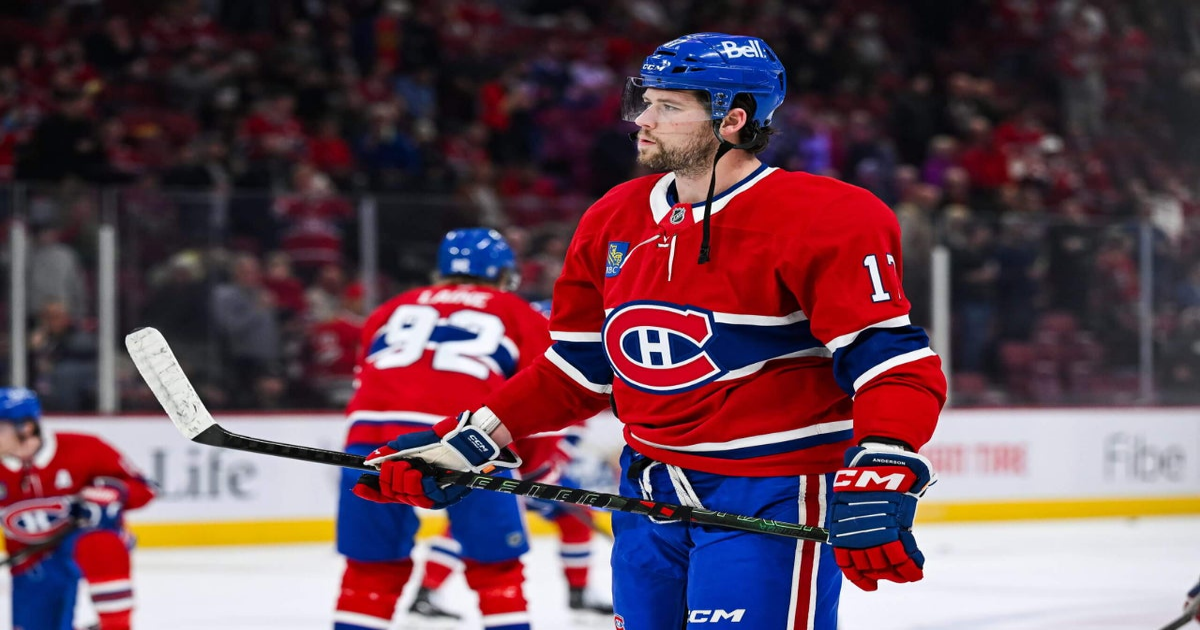WASHINGTON — Welcome to the Canadiens weekly notebook, with a new brand and a new schedule.
Our weekly notebooks have come out on Mondays all season, and this week’s also happens to come out on Monday, but they will no longer be weekly because the Montreal Canadiens are in the playoffs. So there will be more of them as long as the Canadiens remain alive. Let’s go.
Mirror-image series
A lot has been made about how the Canadiens faced the Washington Capitals in very similar circumstances in 2010: eight seed versus one seed, minnow versus juggernaut, even going down to that Canadiens team being led up front by a two-way centre who wore No. 14 (Tomas Plekanec and Nick Suzuki) and a goal-scoring winger who wore No. 13 (Mike Cammalleri and Cole Caufield).
But really, what makes this series so striking is how similar this Canadiens team is to the Capitals team that squeaked into the playoffs last season.
The Canadiens’ record this season: 40-31-11 for 91 points with a negative goal differential.
The Capitals’ record last season: 40-31-11 for 91 points with a negative goal differential.
The Canadiens reached the playoffs with fewer points than the Calgary Flames, who missed the playoffs in the West. The Capitals last season reached the playoffs with fewer points than the St. Louis Blues, who also missed the playoffs in the West.
The big difference is last year’s Capitals were an older team; older than league average, with an average age of 30. While some younger players learned from last year’s experience to become major contributors this season, including Aliaksei Protas and Connor McMichael and Rasmus Sandin, the veterans were driving the bus.
The Canadiens this year are being driven by their future as the youngest team in the league to reach the playoffs. Mike Matheson, 31, led the team in total ice time, but the next four leaders are all 25 or younger — Lane Hutson (21), Suzuki (25), Caufield (24) and Juraj Slafkovský (21).
It is the Canadiens’ youth driving their bus, which is what makes them both a bit more vulnerable and a bit more dangerous than the Capitals were when they got swept by the New York Rangers. Yes, the Canadiens lack some playoff experience, though they do have two Stanley Cup winners and much more playoff experience than such a young team would typically have. But they are also so young that it is possible they have not peaked yet. There is an unknown element to them that last year’s Capitals might not have had.
And that’s not even considering the Canadiens adding Ivan Demidov with two games left in the regular season, something Capitals coach Spencer Carbery acknowledged Sunday as a potential X-factor for the Canadiens that is difficult to prepare for.

“He can control the puck,” Carbery said regarding the play Demidov made on Connor Murphy on his assist to Alex Newhook for his first NHL point. “He’s not trying to move it quick. He’s willing to hold on to it. That’s not an easy skill for young players. That takes poise, that takes confidence, that takes really intelligent hockey sense, when a D over-pursues and you cut back like that.
“So, yeah, there’s going to be a feeling-out process for our guys of getting comfortable playing against him and seeing what he’s all about, because I agree with the assessment. He can absolutely be an X-factor.”
Newhook, for one, doesn’t really need much convincing of that.
“I think sky’s the limit for that guy,” he told reporters in Brossard after practice Sunday. “I think he can be a real difference-maker in this series. Obviously it’s only two games, but I don’t think the league or teams realize what he’s bringing to the table.”
So yes, the Canadiens are very similar to last year’s Capitals. Does that mean they will suffer the same fate?
Not necessarily.
Anderson the heat-seeking missile
There was an interesting tidbit earlier this season.
Just prior to facing Tom Wilson and the Capitals, San Jose Sharks forward Zack Ostapchuk — who saw plenty of Wilson and Josh Anderson when with the Ottawa Senators before being involved in the Fabian Zetterlund trade — mentioned who he modeled his game after. Ostapchuk is a physical player who has that as his calling card, so this reveal was not all that surprising.
Ostapchuk said yesterday that he models his game after Tom Wilson & Josh Anderson.
A reporter teased him, “Are you going to pick Tom Wilson’s brain tomorrow?”
Looks like Ostapchuk just picked something else with Wilson! Welcome to the Sharks!
— Sheng Peng (@Sheng_Peng) March 15, 2025
Now Wilson and Anderson are facing off against each other, and they each play a critical role in their team’s ability to punish the opposing team’s defence on puck retrievals.
The last time Anderson played in the playoffs, it was the Toronto Maple Leafs’ defence corps that felt the brunt of his aggression in the first round. He scored one goal in that series but was an incredibly impactful player, something that could be seen every time a Maple Leafs defenceman went back into his zone to retrieve a puck with Anderson on the ice.
More often than not, that defenceman just fired that puck around the boards to get it off his stick as quickly as possible so Anderson couldn’t plaster him against the boards.
Anderson has been waiting four years to do that again. And he sounds ready.
“Just play with more urgency,” Anderson said. “The stage is high right now, and in the playoffs, everybody’s working to compete at a much higher level, a lot more hitting, a lot more physical. It’s a tighter game out there, so any time you can forecheck their top guys, you want to take that opportunity as much as you can. It does a lot in the playoffs. Guys don’t like getting hit and they get beat up. You’ve got to do it as much as you can.”
Anderson and Wilson were both drafted in 2012, 79 picks apart. They faced off against each other in the OHL. They are, in many ways, cut from the same cloth in terms of imposing themselves physically.
Wilson’s physicality is an incredibly important part of the challenge the Capitals present, and Anderson understands he must present the same challenge to the Capitals.
“Anytime he can get a lick on our D, he’s probably going to do that,” Anderson said. “And he’ll see the same thing on our side from myself.”
Canadiens coach Martin St. Louis expects nothing less from Anderson, because he’s seen it for months now. Except the punishment is likely to elevate, because Anderson has a history of doing that in the playoffs.
“It’s critical but I feel he’s been doing that for a long time,” St. Louis said. “I feel we’ve been in the playoffs since Christmas, and you saw what he brings to a game. I expect that, and probably another level. But he’s not the only one, we have other guys that can do that, and we’re going to need that.”
About that …
What will playoff Slafkovský look like?
When the Canadiens took Slafkovský with the No. 1 pick in 2022, it was with this situation in mind. He was drafted for what he might do in the playoffs. And the potential physicality in his game is what drove that belief.
The thing is, Slafkovský is not a naturally physical player. He sees himself as a skill player, always has. The physical part is something he has had to learn, and it is perhaps his biggest sign of growth this season, though the consistency of that part of his game has had its share of ebbs and flows.
Slafkovský knows what the team needs from him to be successful. He needs to be a lot like Anderson, because if he is, that means two Capitals defence pairings are feeling that wrath on the forecheck instead of just the one Anderson is on the ice against.
“I hate to talk about it because you say things and you never know what’s going to happen,” Slafkovský said Sunday. “But I want to bring energy, I want to get the team going from the first shift, I want to be physical, I want to win pucks and score a couple of goals and be happy after the game.”
The reason Slafkovský doesn’t want to talk about it is because he knows he has talked about it often this season and it has not necessarily always shown up in games. He wants to go out and do it before talking about it, but talking about it at least shows that he knows what he needs to do. It has been drilled into him by the coaching staff all season, but it is something St. Louis admits is not necessarily natural in him like it is in Anderson or Wilson.
“I think it’s more acquired,” St. Louis said. “Slaf has skill, but it has to start with his pace and physicality, and after that the skill can come in.”

We have seen this problem before: Big players who see themselves as skill players but are expected to be physical because they are big players. When the physicality is forced, it rarely works. It needs to be embraced, and in that sense, this is a big test for Slafkovský.
He knows this is how he is most effective. But he also knows his calling card is his skill. He has always known that and has always resisted being defined by his size.
In his first playoffs, the games he was drafted to play in, Slafkovský needs to buy in to a good balance between the skill part of his game and the fact he has all that skill packaged in a massive body.
“Understanding his biggest asset is his size and his physicality,” St. Louis said when asked what the biggest improvement was for Slafkovský this season. “When that’s at the forefront of his game, the rest comes with it.”
The special teams chess match
The Capitals’ power play represents a challenge in that Alex Ovechkin basically stands in his spot and waits for opportunities. Those opportunities generally come, and when they do, Ovechkin generally buries them.
So how does Jake Evans, the NHL leader in short-handed ice time among forwards, feel about that?
“I think there’s a fine line,” Evans said. “I remember one of my first years we literally just followed him, one guy had to stay on him the whole power play. When you do that, he’ll just go to the corner and make it a four-on-three. So it’s a fine line. You need to obviously be aware of him because it doesn’t take him long to score, but you don’t want to just focus on that because it just opens up more.”
That is just one part of it.
The Canadiens’ power play has a similar weapon at the left circle in Patrik Laine, but the Canadiens have been unable to exploit it to its full potential. Figuring that out could go a long way in the Canadiens figuring out how to pull off the upset against the Capitals.
St. Louis is focused on playing the Canadiens’ brand of hockey regardless of what the Capitals do. But on special teams, he is willing to make adjustments based on what they are doing. And freeing up Laine more than they have recently should be a priority.
“Obviously the special teams, I think there’s going to be some tweaking a little bit,” St. Louis said. “I think it’s a cat and mouse game in that department.”
(Top photo of Josh Anderson: David Kirouac / Imagn Images)



